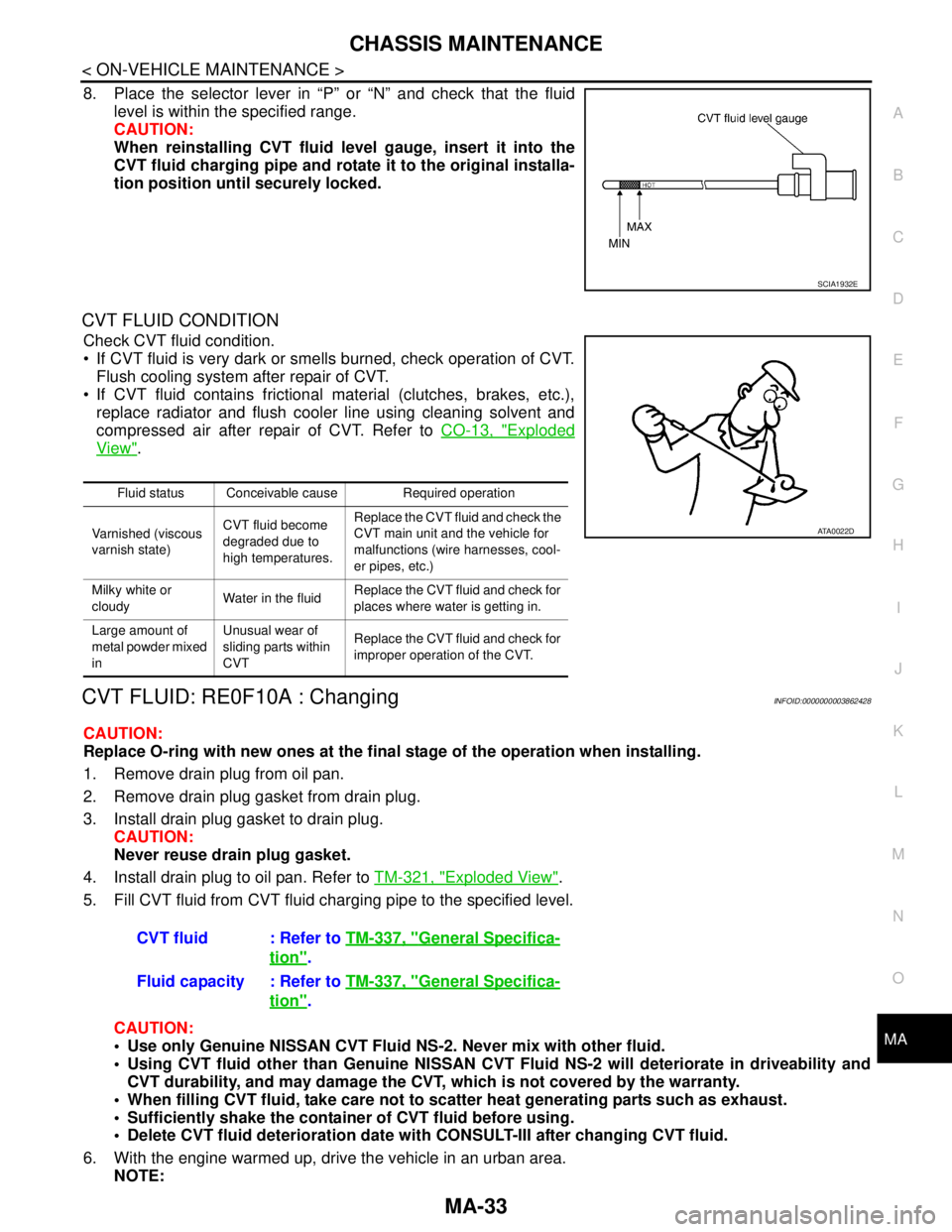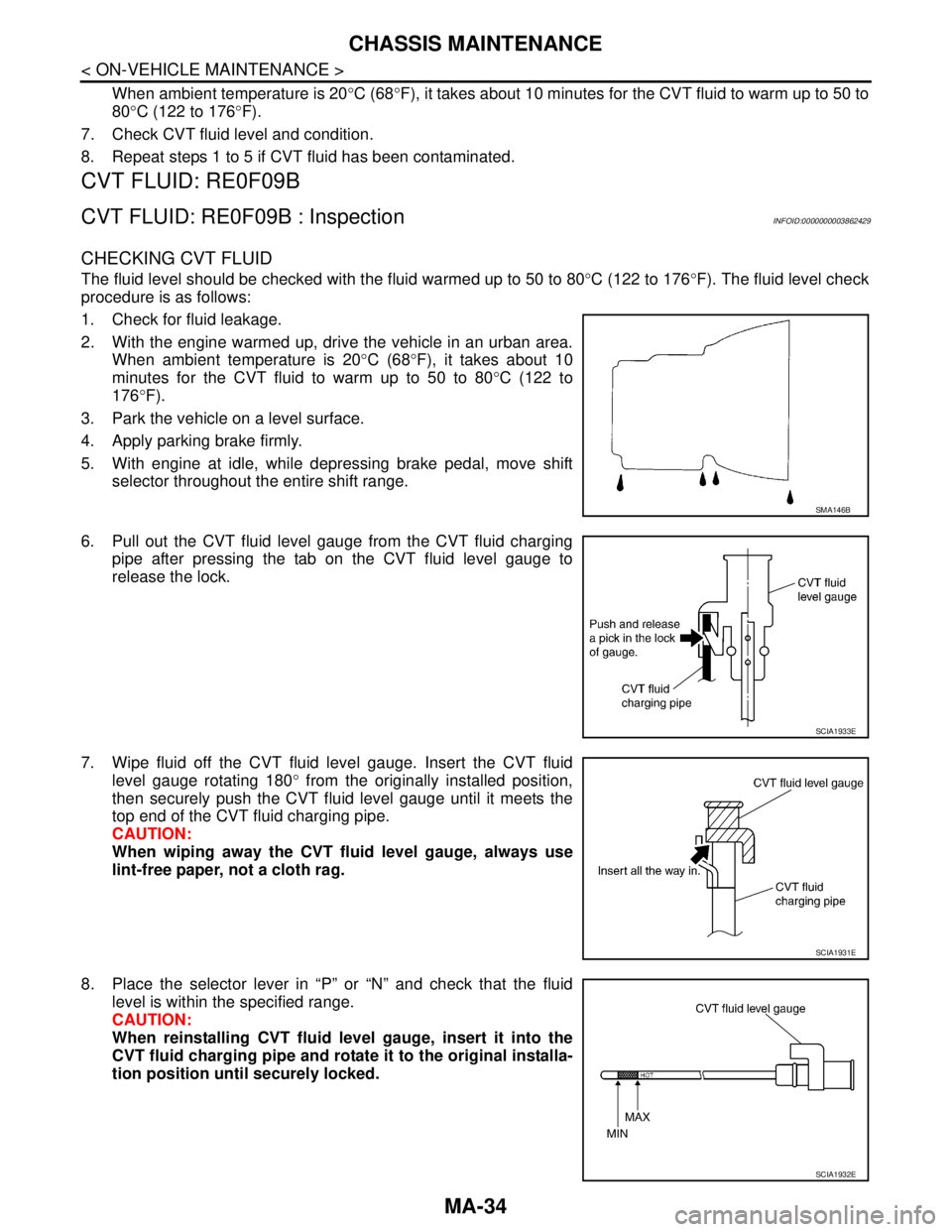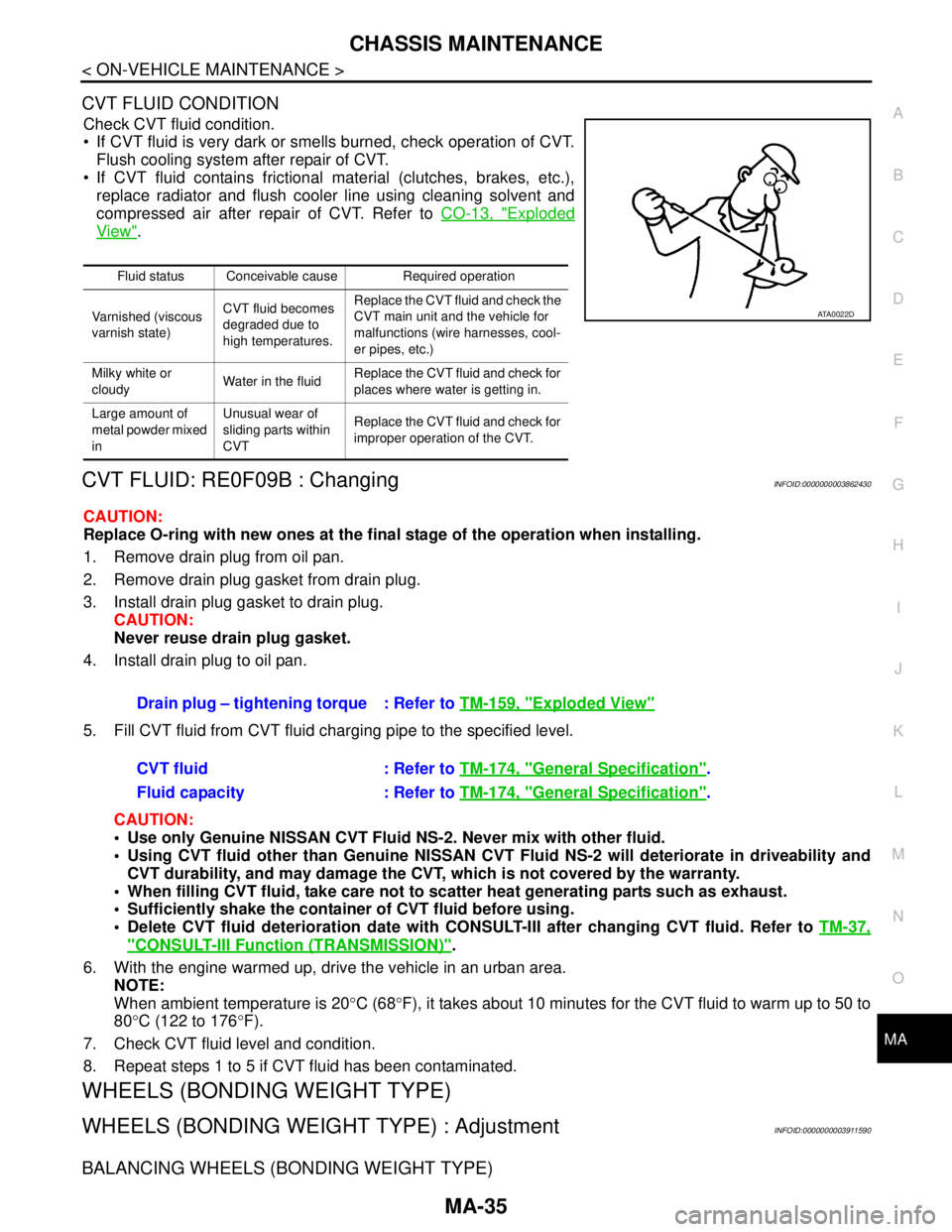2008 NISSAN TEANA charging
[x] Cancel search: chargingPage 3221 of 5121

CHASSIS MAINTENANCE
MA-33
< ON-VEHICLE MAINTENANCE >
C
D
E
F
G
H
I
J
K
L
MB
MAN
OA
8. Place the selector lever in “P” or “N” and check that the fluid
level is within the specified range.
CAUTION:
When reinstalling CVT fluid level gauge, insert it into the
CVT fluid charging pipe and rotate it to the original installa-
tion position until securely locked.
CVT FLUID CONDITION
Check CVT fluid condition.
If CVT fluid is very dark or smells burned, check operation of CVT.
Flush cooling system after repair of CVT.
If CVT fluid contains frictional material (clutches, brakes, etc.),
replace radiator and flush cooler line using cleaning solvent and
compressed air after repair of CVT. Refer to CO-13, "
Exploded
View".
CVT FLUID: RE0F10A : ChangingINFOID:0000000003862428
CAUTION:
Replace O-ring with new ones at the final stage of the operation when installing.
1. Remove drain plug from oil pan.
2. Remove drain plug gasket from drain plug.
3. Install drain plug gasket to drain plug.
CAUTION:
Never reuse drain plug gasket.
4. Install drain plug to oil pan. Refer to TM-321, "
Exploded View".
5. Fill CVT fluid from CVT fluid charging pipe to the specified level.
CAUTION:
Use only Genuine NISSAN CVT Fluid NS-2. Never mix with other fluid.
Using CVT fluid other than Genuine NISSAN CVT Fluid NS-2 will deteriorate in driveability and
CVT durability, and may damage the CVT, which is not covered by the warranty.
When filling CVT fluid, take care not to scatter heat generating parts such as exhaust.
Sufficiently shake the container of CVT fluid before using.
Delete CVT fluid deterioration date with CONSULT-III after changing CVT fluid.
6. With the engine warmed up, drive the vehicle in an urban area.
NOTE:
SCIA1932E
Fluid status Conceivable cause Required operation
Varnished (viscous
varnish state)CVT fluid become
degraded due to
high temperatures.Replace the CVT fluid and check the
CVT main unit and the vehicle for
malfunctions (wire harnesses, cool-
er pipes, etc.)
Milky white or
cloudyWater in the fluidReplace the CVT fluid and check for
places where water is getting in.
Large amount of
metal powder mixed
inUnusual wear of
sliding parts within
CVTReplace the CVT fluid and check for
improper operation of the CVT.
ATA0022D
CVT fluid : Refer to TM-337, "General Specifica-
tion".
Fluid capacity : Refer to TM-337, "
General Specifica-
tion".
Page 3222 of 5121

MA-34
< ON-VEHICLE MAINTENANCE >
CHASSIS MAINTENANCE
When ambient temperature is 20°C (68°F), it takes about 10 minutes for the CVT fluid to warm up to 50 to
80°C (122 to 176°F).
7. Check CVT fluid level and condition.
8. Repeat steps 1 to 5 if CVT fluid has been contaminated.
CVT FLUID: RE0F09B
CVT FLUID: RE0F09B : InspectionINFOID:0000000003862429
CHECKING CVT FLUID
The fluid level should be checked with the fluid warmed up to 50 to 80°C (122 to 176°F). The fluid level check
procedure is as follows:
1. Check for fluid leakage.
2. With the engine warmed up, drive the vehicle in an urban area.
When ambient temperature is 20°C (68°F), it takes about 10
minutes for the CVT fluid to warm up to 50 to 80°C (122 to
176°F).
3. Park the vehicle on a level surface.
4. Apply parking brake firmly.
5. With engine at idle, while depressing brake pedal, move shift
selector throughout the entire shift range.
6. Pull out the CVT fluid level gauge from the CVT fluid charging
pipe after pressing the tab on the CVT fluid level gauge to
release the lock.
7. Wipe fluid off the CVT fluid level gauge. Insert the CVT fluid
level gauge rotating 180° from the originally installed position,
then securely push the CVT fluid level gauge until it meets the
top end of the CVT fluid charging pipe.
CAUTION:
When wiping away the CVT fluid level gauge, always use
lint-free paper, not a cloth rag.
8. Place the selector lever in “P” or “N” and check that the fluid
level is within the specified range.
CAUTION:
When reinstalling CVT fluid level gauge, insert it into the
CVT fluid charging pipe and rotate it to the original installa-
tion position until securely locked.
SMA146B
SCIA1933E
SCIA1931E
SCIA1932E
Page 3223 of 5121

CHASSIS MAINTENANCE
MA-35
< ON-VEHICLE MAINTENANCE >
C
D
E
F
G
H
I
J
K
L
MB
MAN
OA
CVT FLUID CONDITION
Check CVT fluid condition.
If CVT fluid is very dark or smells burned, check operation of CVT.
Flush cooling system after repair of CVT.
If CVT fluid contains frictional material (clutches, brakes, etc.),
replace radiator and flush cooler line using cleaning solvent and
compressed air after repair of CVT. Refer to CO-13, "
Exploded
View".
CVT FLUID: RE0F09B : ChangingINFOID:0000000003862430
CAUTION:
Replace O-ring with new ones at the final stage of the operation when installing.
1. Remove drain plug from oil pan.
2. Remove drain plug gasket from drain plug.
3. Install drain plug gasket to drain plug.
CAUTION:
Never reuse drain plug gasket.
4. Install drain plug to oil pan.
5. Fill CVT fluid from CVT fluid charging pipe to the specified level.
CAUTION:
Use only Genuine NISSAN CVT Fluid NS-2. Never mix with other fluid.
Using CVT fluid other than Genuine NISSAN CVT Fluid NS-2 will deteriorate in driveability and
CVT durability, and may damage the CVT, which is not covered by the warranty.
When filling CVT fluid, take care not to scatter heat generating parts such as exhaust.
Sufficiently shake the container of CVT fluid before using.
Delete CVT fluid deterioration date with CONSULT-III after changing CVT fluid. Refer to TM-37,
"CONSULT-III Function (TRANSMISSION)".
6. With the engine warmed up, drive the vehicle in an urban area.
NOTE:
When ambient temperature is 20°C (68°F), it takes about 10 minutes for the CVT fluid to warm up to 50 to
80°C (122 to 176°F).
7. Check CVT fluid level and condition.
8. Repeat steps 1 to 5 if CVT fluid has been contaminated.
WHEELS (BONDING WEIGHT TYPE)
WHEELS (BONDING WEIGHT TYPE) : AdjustmentINFOID:0000000003911590
BALANCING WHEELS (BONDING WEIGHT TYPE)
Fluid status Conceivable cause Required operation
Varnished (viscous
varnish state)CVT fluid becomes
degraded due to
high temperatures.Replace the CVT fluid and check the
CVT main unit and the vehicle for
malfunctions (wire harnesses, cool-
er pipes, etc.)
Milky white or
cloudyWater in the fluidReplace the CVT fluid and check for
places where water is getting in.
Large amount of
metal powder mixed
inUnusual wear of
sliding parts within
CVTReplace the CVT fluid and check for
improper operation of the CVT.
ATA0022D
Drain plug – tightening torque : Refer to TM-159, "Exploded View"
CVT fluid : Refer to TM-174, "General Specification".
Fluid capacity : Refer to TM-174, "
General Specification".
Page 3429 of 5121
![NISSAN TEANA 2008 Service Manual PCS-38
< FUNCTION DIAGNOSIS >[POWER DISTRIBUTION SYSTEM]
POWER DISTRIBUTION SYSTEM
FUNCTION DIAGNOSIS
POWER DISTRIBUTION SYSTEM
System DescriptionINFOID:0000000003805720
PDS (POWER DISTRIBUTION SYST NISSAN TEANA 2008 Service Manual PCS-38
< FUNCTION DIAGNOSIS >[POWER DISTRIBUTION SYSTEM]
POWER DISTRIBUTION SYSTEM
FUNCTION DIAGNOSIS
POWER DISTRIBUTION SYSTEM
System DescriptionINFOID:0000000003805720
PDS (POWER DISTRIBUTION SYST](/manual-img/5/57391/w960_57391-3428.png)
PCS-38
< FUNCTION DIAGNOSIS >[POWER DISTRIBUTION SYSTEM]
POWER DISTRIBUTION SYSTEM
FUNCTION DIAGNOSIS
POWER DISTRIBUTION SYSTEM
System DescriptionINFOID:0000000003805720
PDS (POWER DISTRIBUTION SYSTEM) is the system that BCM controls with the operation of the push-
button ignition switch and performs the power distribution to each power circuit. This system is used instead
of the mechanical power supply changing mechanism with the operation of the conventional key cylinder.
The push-button ignition switch can be operated when Intelligent Key is in the following condition. Refer to
Engine Start Function for details.
- Intelligent Key is in the detection area of the inside key antenna
- Insert Intelligent Key into the key slot
- Insert key fob into the key slot
The push-button ignition switch operation is input to BCM as a signal. BCM changes the power supply posi-
tion according to the status and operates the following relays to supply power to each power circuit.
- Ignition relay (built into IPDM E/R)
- Ignition relay (inserted into fuse block)
- ACC relay
- Blower fan relay
NOTE:
The engine switch operation changes due to the conditions of brake pedal, selector lever and vehicle speed.
The power supply position can be confirmed with the illuminating of the indicators around the push-button
ignition switch.
BATTERY SAVER SYSTEM
When all of the following conditions are met for 60 minutes, the battery saver system will cut off the power sup-
ply to prevent battery discharge.
The ignition switch is in the ACC position
All doors are closed
Selector lever is in the P position
Reset Condition of Battery Saver System
In order to prevent the battery from discharging, the battery saver system will cut off the power supply when all
doors are closed, the selector lever is in the P position and the ignition switch is left in the ACC position for 60
minutes. If any of the following conditions are met the battery saver system is released and the steering will
change automatically to the LOCK position from the OFF position.
Opening any door
Operating with door key cylinder on door lock
Operating with request switch on door lock
Operating with Intelligent Key on door lock
Press push-button ignition switch and ignition switch will change to the ACC position from the OFF position.
STEERING LOCK OPERATION
Steering is locked by steering lock unit when ignition switch is in the OFF position, selector lever is in the P
position and any of the following conditions are met.
Opening door
Closing door
Door is locked with request switch
Door is locked with Intelligent Key
PUSH-BUTTON IGNITION SWITCH OPERATION PROCEDURE
The power supply position changing operation can be performed with the following operations.
Operation Enable Condition
When an Intelligent Key is within the detection area of inside key antenna and when it is inserted into the key
slot, the operation is as per the following.
When starting the engine, the BCM monitors the following engine start conditions,
- Brake pedal operating condition
- Selector lever position
- Vehicle speed
Unless each start condition is fulfilled, the engine will not respond regardless of how many times the engine
switch is pressed. At that time, illumination repeats the position in the order of LOCK→ACC→ON→OFF.
Page 3519 of 5121

PG
PG-1
ELECTRICAL & POWER CONTROL
C
DE
F
G H
I
J
K L
B
SECTION PG
A
O P
N
CONTENTS
POWER SUPPLY, GROUND & CIRCUIT ELEMENTS
POWER SUPPLY&GR
OUND CIRCUIT
BASIC INSPECTION ....... .............................
3
BATTERY ....................................................... .....3
How to Handle Battery ........................................ ......3
Work Flow .................................................................5
COMPONENT DIAGNOSIS .........................10
POWER SUPPLY ROUTING CIRCUIT .......... ....10
Wiring Diagram - BATTERY POWER SUPPLY - ....10
Wiring Diagram - BATTERY POWER SUPPLY
FUSE No. 6 - ....................................................... ....
25
Wiring Diagram - BATTERY POWER SUPPLY
FUSE No. 11 - .........................................................
27
Wiring Diagram - BATTERY POWER SUPPLY
FUSE No. 31 - .........................................................
29
Wiring Diagram - BATTERY POWER SUPPLY
FUSE No. 50 - .........................................................
32
Wiring Diagram - BATTERY POWER SUPPLY
FUSE No. 52 - .........................................................
36
Wiring Diagram - BATTERY POWER SUPPLY
FUSE No. 53 - .........................................................
38
Wiring Diagram - ACCESSORY POWER SUP-
PLY - .......................................................................
48
Wiring Diagram - ACCESSORY POWER SUP-
PLY FUSE No. 19 - .................................................
51
Wiring Diagram - IGNITION POWER SUPPLY - ....55
Wiring Diagram - IGNITION POWER SUPPLY
FUSE No. 3 - ...........................................................
65
Wiring Diagram - IGNITION POWER SUPPLY
FUSE No. 4 - ...........................................................
74
Wiring Diagram - IGNITION POWER SUPPLY
FUSE No. 43 - .........................................................
77
Wiring Diagram - IGNITION POWER SUPPLY
FUSE No. 44 - .........................................................
79
Fuse ........................................................................82
Fusible Link .............................................................82
Circuit Breaker ........................................................82
HARNESS LAYOUT .........................................83
How To Read Harness Layout ............................ ....83
Outline .....................................................................84
Main Harness ..........................................................85
Engine Room Harness ............................................86
Engine Control Harness ..........................................88
Body Harness ..........................................................89
Body No. 2 Harness ................................................90
Room Lamp Harness ...............................................91
Front Door Harness (LH Side) .................................92
Front Door Harness (RH Side) ................................93
Rear Door Harness (LH Side) .................................94
Rear Door Harness (RH Side) .................................95
HARNESS CONNECTOR .................................96
Description ...............................................................96
STANDARDIZED RELAY .................................99
Description ...............................................................99
FUSE BLOCK - JUNCTION BOX (J/B) ..........101
Fuse, Connector and Terminal Arrangement ........101
FUSE, FUSIBLE LINK AND RELAY BOX ......102
Fuse and Fusible Link Arrangement ......................102
IPDM E/R (INTELLIGENT POWER DISTRI-
BUTION MODULE ENGINE ROOM) ..............
103
Fuse, Connector and Terminal Arrangement ........103
PRECAUTION ............................................104
PRECAUTIONS ...............................................104
Precaution for Supplemental Restraint System
(SRS) "AIR BAG" and "SEAT BELT PRE-TEN-
SIONER" ............................................................. ..
104
ON-VEHICLE MAINTENANCE ..................105
BATTERY CHARGING CHART ......................105
Slow Charge ........................................................ ..105
Standard Charge ...................................................106
Page 3521 of 5121
![NISSAN TEANA 2008 Service Manual PG
BATTERY
PG-3
< BASIC INSPECTION >[POWER SUPPLY&GROUND CIRCUIT]
C
D
E
F
G
H
I
J
K
L B A
O
P N
BASIC INSPECTION
BATTERY
How to Handle BatteryINFOID:0000000003809460
CAUTION:
• If it becomes necessa NISSAN TEANA 2008 Service Manual PG
BATTERY
PG-3
< BASIC INSPECTION >[POWER SUPPLY&GROUND CIRCUIT]
C
D
E
F
G
H
I
J
K
L B A
O
P N
BASIC INSPECTION
BATTERY
How to Handle BatteryINFOID:0000000003809460
CAUTION:
• If it becomes necessa](/manual-img/5/57391/w960_57391-3520.png)
PG
BATTERY
PG-3
< BASIC INSPECTION >[POWER SUPPLY&GROUND CIRCUIT]
C
D
E
F
G
H
I
J
K
L B A
O
P N
BASIC INSPECTION
BATTERY
How to Handle BatteryINFOID:0000000003809460
CAUTION:
• If it becomes necessary to start the engine with a booster battery and jumper cables, use a 12-volt
booster battery.
After connecting battery cables, ensure that they are tightly clamped to battery terminals for good
contact.
Never add distilled water through the hole used to check specific gravity.
METHODS OF PREVENTING OVER-DISCHARGE
The following precautions must be taken to prevent over-discharging a battery.
• The battery surface (particularly its top) should always be kept
clean and dry.
The terminal connections should be clean and tight.
At every routine maintenance, check the electrolyte level.
This also applies to batteries designated as “low maintenance” and
“maintenance-free”.
When the vehicle is not going to be used over a long period of
time, disconnect the battery cable from the negative terminal. (If
the vehicle has an extended storage switch, turn it off.)
Check the charge condition of the battery.
Periodically check the specific gravity of the electrolyte. Keep a
close check on charge condition to prevent over-discharge.
CHECKING ELECTROLYTE LEVEL
WARNING:
Never allow battery fluid to come in contact with skin, eyes, fabrics, or painted surfaces. After touch-
ing a battery, never touch or rub your eyes until you have thoroughly washed your hands. If acid con-
tacts eyes, skin or clothing, immediately flush with water for 15 minutes and seek medical attention.
MEL040F
ELA0349D
MEL042F
Page 3522 of 5121
![NISSAN TEANA 2008 Service Manual PG-4
< BASIC INSPECTION >[POWER SUPPLY&GROUND CIRCUIT]
BATTERY
Remove the cell plug using a suitable tool.
Add distilled water up to the MAX level.
Sulphation
A battery will be completely discharg NISSAN TEANA 2008 Service Manual PG-4
< BASIC INSPECTION >[POWER SUPPLY&GROUND CIRCUIT]
BATTERY
Remove the cell plug using a suitable tool.
Add distilled water up to the MAX level.
Sulphation
A battery will be completely discharg](/manual-img/5/57391/w960_57391-3521.png)
PG-4
< BASIC INSPECTION >[POWER SUPPLY&GROUND CIRCUIT]
BATTERY
Remove the cell plug using a suitable tool.
Add distilled water up to the MAX level.
Sulphation
A battery will be completely discharged if it is left unattended
for a long time and the specific gravity will become less than
1.100. This may result in sulphation on the cell plates.
To determine if a battery has been “sulphated”, note its voltage
and current when charging it. As shown in the figure, less cur-
rent and higher voltage are observed in the initial stage of
charging sulphated batteries.
A sulphated battery may sometimes be brought back into ser-
vice by means of a long, slow charge, 12 hours or more, fol-
lowed by a battery capacity test.
SPECIFIC GRAVITY CHECK
1. Read hydrometer and thermometer indications at eye level.
2. Convert into specific gravity at 20°C (68°F).
Example: When electrolyte temperature is 35°C (95°F) and specific gravity of
electrolyte is 1.230, converted specific gravity at 20°C (68°F) is
1.240.
When electrolyte temperature is 0°C (32°F) and specific gravity of
electrolyte is 1.210, converted specific gravity at 20°C (68°F) is
1.196.
MEL043F
PKIA2353E
MEL042FA
SEL007Z
Page 3524 of 5121
![NISSAN TEANA 2008 Service Manual PG-6
< BASIC INSPECTION >[POWER SUPPLY&GROUND CIRCUIT]
BATTERY
3. If the difference between the max. and min. electrolyte level in cells is within 10 mm (0.39 in), it is OK.
Are these inspection resul NISSAN TEANA 2008 Service Manual PG-6
< BASIC INSPECTION >[POWER SUPPLY&GROUND CIRCUIT]
BATTERY
3. If the difference between the max. and min. electrolyte level in cells is within 10 mm (0.39 in), it is OK.
Are these inspection resul](/manual-img/5/57391/w960_57391-3523.png)
PG-6
< BASIC INSPECTION >[POWER SUPPLY&GROUND CIRCUIT]
BATTERY
3. If the difference between the max. and min. electrolyte level in cells is within 10 mm (0.39 in), it is OK.
Are these inspection results normal?
YES >> GO TO 2.
NO >> Replace battery.
2.CHECKING SPECIFIC GRAVITY
Check specific gravity. Refer to PG-3, "
How to Handle Battery".
Inspection results
Above 1.220 (Test using battery checker)>>GO TO 3.
Above 1.220 (Test using load tester)>>GO TO 5.
1.100 - 1.220 (When performing quick charge)>>GO TO 7.
1.100 - 1.220 (When performing standard charge)>>GO TO 12.
Below 1.100>>GO TO 13.
3.CAPACITY TEST
Test using battery checker.
Is the battery usable, according to the manufacturer
’s instructions?
YES >> Ready for use. Mount battery again and check loose terminals. Also check other related circuits.
NO >> GO TO 4.
4.QUICK CHARGE
1. Perform quick charge. Time required: 45 min. Refer to PG-107, "
Quick Charge".
2. Test using battery checker.
Is the battery usable, according to the manufacturer
’s instructions?
YES >> Ready for use.
NO >> Replace battery.
5.CAPACITY TEST
1. Test using load tester.
2. Check battery type and determine the specified current using the table.
Discharging Current (Load Tester)
3. Read load tester voltage when specified discharging current flows through battery for 15 seconds.
Type Current (A)
28B19R(L) 90
34B19R(L) 99
46B24R(L)
135
55B24R(L)
50D23R(L) 150
55D23R(L) 180
80D23R(L)
195 65D26R(L)
80D26R(L)
75D31R(L) 210
95D31R(L)
240 115D31R(L)
025 [YUASA type code]
027 [YUASA type code] 285
110D26R(L)
300
95E41R(L)
067 [YUASA type code] 325
130E41R(L) 330
096 [YUASA type code] 375